Horrible History: Colour-blind history
- Tastes Of History
- Mar 26
- 22 min read
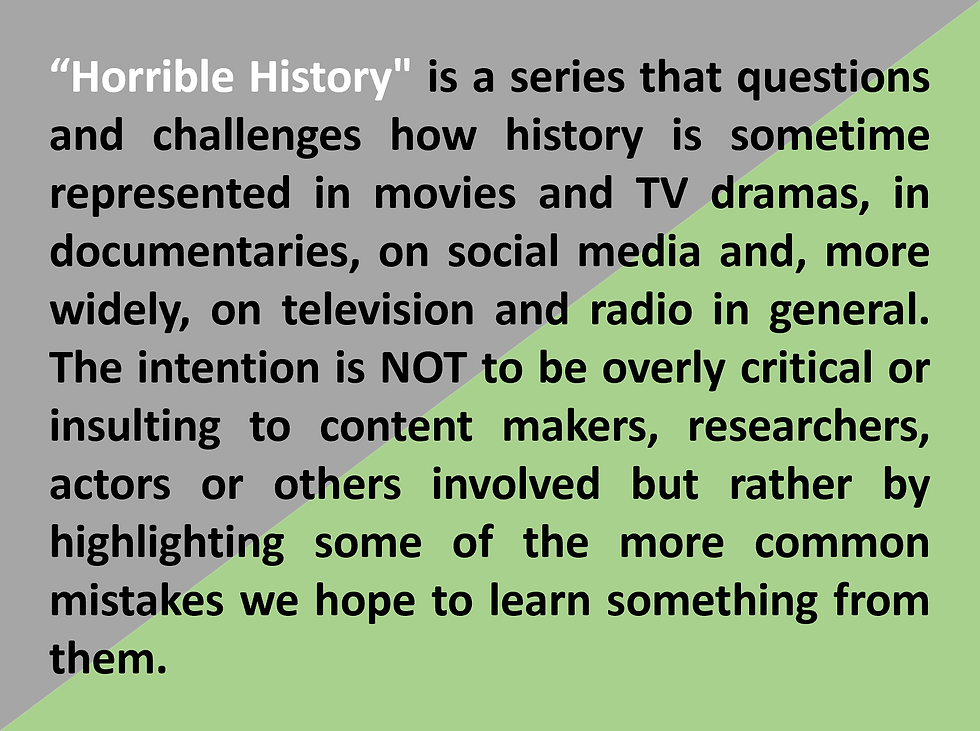
It is clearly the trendy (dare we say “woke”) thing to portray historical figures in dramas and documentaries with actors and actresses whose appearance diverges from known, provable representations. In the 21st-century we are encouraged to be gender neutral or colour blind in portrayals of ourselves in the media whether that be on television, in films, in video games, or even in textbooks. In recent years, there been an increased impetus for greater diversity and inclusion in the workplace and other spheres of society. Many organizations now actively work to create more inclusive environments by addressing the underrepresentation of various social groups. Such actions are laudably the right thing to do, but sometimes not all attempts at fostering diversity and inclusivity are created equal. One problematic approach that has seemingly emerged is “forced diversity” when organizations or institutions mandate the inclusion of individuals from diverse backgrounds based solely on factors such as their gender, race, ethnicity, or sexual orientation. But this is not the same as organically fostering an inclusive environment because such approaches often result in “tokenism” where individuals are included primarily based on their diverse attributes rather than on their skills and qualifications. While the intentions behind forced diversity may be well-meaning, its somewhat superficial nature can lead to a variety of unintended consequences and harmful outcomes.

Before proceeding it might be worth explaining the jargon. In some quarters forced diversity is popularly referred to as “blackwashing”, but this is a derogatory term for the revisionist portrayal of someone or something as belonging to a black race of people. Its antonym “whitewashing” is likewise a derogatory term for the process of making over (a person or character, a group, an event, etc.) so that it either is or seems more “white”, more Caucasian. “Whitewashing” may include, for example, replacing an original character of colour (or of a minority group) with a white character, person or actor. It can also mean the literal application of makeup to a person to alter their ethnicity, or masking the involvement of non-whites in an event to focus only on white participation. It has been done many times in movies and television shows, but in more recent times has declined significantly.
So, if we agree that “whitewashing” is unacceptable, then the same must be true for “blackwashing”. There would be understandable outrage if a white actor was hired to play, for example, the African warrior king Shaka Zulu. Accusations of racism and calls for the film, its producers and the broadcaster or distributor to be boycotted would undoubtedly swiftly follow. All of which is perfectly reasonable and appropriate. But does having a black or Asian actor playing an ethnically white historical character make the story more inclusive or is it just the entertainment world forcing diversity on audiences. More alarmingly from the historian’s perspective, is this evidence of deliberate disinformation? Why do it at all when it is so unnecessary? Why not bring to life, on the big and small screen, the true stories of Africans, Asians and minority groups with actors and actresses befitting the characters.
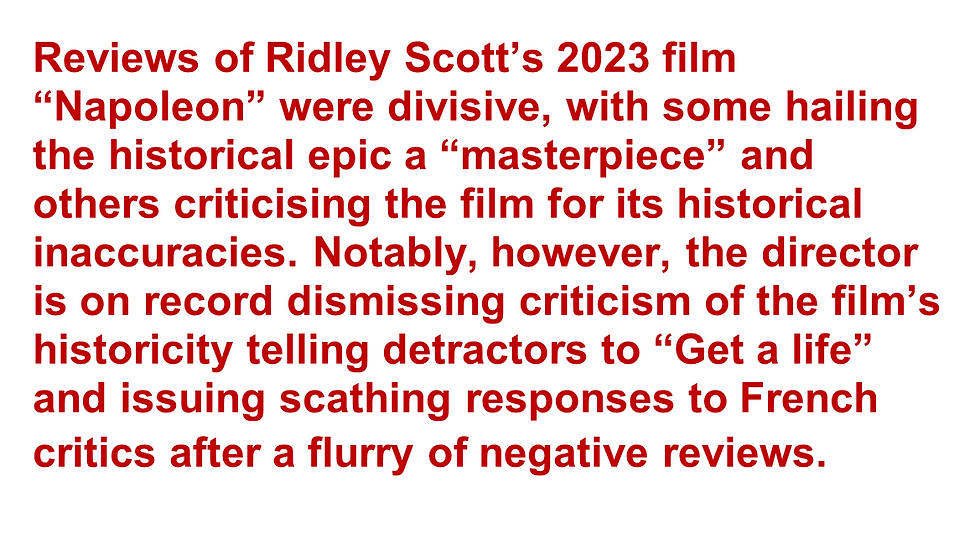
Forced diversity is evidently a factor in “identity-conscious casting” or “colour-blind casting”, two interchangeable terms that are increasingly the fashion in the stage, film and television industries. It has also become trendy for playwrights, filmmakers and novelists to use history as a stimulus for artistic licence - material often exploited and abused for dramatic effect. It is quite clear that their considerations are audience appeal, profit and, far too frequently, politics. As far as the media is concerned (cf. Ridley Scott’s reaction to criticism), historians can deal with the facts and worry about the truth. Of course, some historians can be guilty of distortion and sloppy analysis, but to be plain wrong is both unethical and unprofessional. So, when we view documentaries wilfully misrepresenting characters and events, then the makers are open to accusations of leaving audiences ignorant of what is true or false. This is straightforward mendacity and always should be challenged. As Simon Jenkins (author, Guardian columnist and BBC broadcaster) wrote in “The Conversation” for BBC History Magazine [1]: “artistic licence should not be a licence to deceive.”
For current purposes, if actors are hired only to satisfy a perceived need for inclusion and diversity, then this is effectively creating false representation, or misrepresentation. So, when a traditionally deemed white character is portrayed by a person of colour, it is fair to reproach the production company of, at best, identity-conscious casting or, at worst, forced diversity. Interestingly, albeit somewhat perversely, these “colour-blind” decisions (which hopefully we can agree are being made for all the right reasons, probably) can perpetuate the tokenism alluded to earlier. Individuals included for their demographic characteristics rather than on merit or for their qualifications makes it easier for detractors to see them not as valued contributors but merely “tokens”. As such, these casting choices risk reinforcing negative stereotypes that, in turn, could breed resentment in those who may feel their qualifications and skills have been overlooked in appeasement to inclusivity and diversity.
Interestingly, in March 2022 Stefan Aguirre Quiroga wrote the following in defence of the idea that forced diversity is not a thing:
“When people of color [sic] enter spaces historically perceived as ‘white’ in popular representations of history and speculative fiction, familiar outcries of ‘blackwashing’ or ‘forced diversity’ are sure to follow. What is it exactly that white people fear losing?”
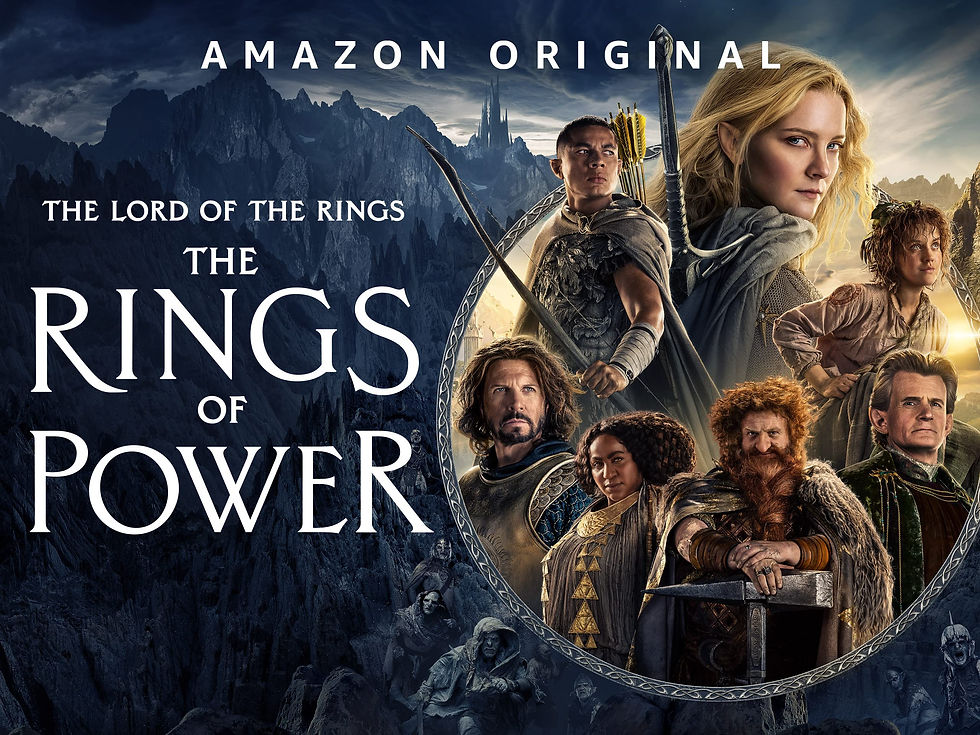
But is this true? One can argue that a black actor or actress playing any character in fiction, whether “speculative” or not, is not really the issue. Besides, the final sentence of the quote is clearly intended to be provocative. Where a character is black or Asian in a modern-day story or one set in a fictional past or an imagined future, then it is irrelevant whether the reader or viewer is “white” or otherwise. Mr Quiroga’s article also highlighted allegations of “forced diversity” in Amazon TV's series “The Lord of the Rings: The Rings of Power”. Yet the case he uses to illustrate his point is in reality a straw man fallacy [2] and rather immaterial to the question at hand as this series is a prequel clearly set in fantasy world. Whether one can argue Tolkein’s magnum opus was a commentary on post-war Britain - and perhaps more widely, Europe - it is certainly not a history of these isles [3].
Consequently, there really are no limits on who may be cast to play the various fictional characters in such a fantasy setting. Whether the cast chimes with a particular reader’s or viewer’s preconceived notions is another matter entirely, and one for that individual to deal with.
“Whitewashing” Historical settings are a different matter, however. The first example is a rather dated instance but does speak to how things used to be done but, as we shall see, it is not an isolated case. In the early 20th-century, it was not unusual for white actors to caricature different ethnicities adopting “blackface” to portray Africans, or the equivalent “yellowface” for East Asians. Both practices typically involved the performers using theatrical makeup (or burned cork, shoe polish, etc.) to caricature black or Asian people on stage or in entertainment. The practice of blackface may have its origins as early as Medieval Europe's mystery plays when bitumen and coal were used to darken the skin of white performers portraying demons, devils, and damned souls. It should not need to be said but, just in case, linking Africans, Asians or any other group of people with “demons, devils, or damned souls” is not to be inferred. Nevertheless, other scholars have dated the practice to English Renaissance theatre in works such as William Shakespeare's Othello which, conveniently, provides a useful case study.
By the mid-20th-century there was far more colour diversity in the film and entertainment industry and blackface had mostly disappeared. The 1965 film Othello was a notable exception, however, as the white actor Laurence Olivier was cast as the title character, “the Moor”, and wore blackface as pictured below left. Jump forward roughly 20 years and 1986 saw the release of director Franco Zeffirelli’s lavish film version of Giuseppe Verdi’s opera Otello based on William Shakespeare’s play. The Spanish tenor Plácido Domingo was cast in the title role (pictured below centre) and “blacked up” accordingly. As Domingo was at the height of his operatic career in the late 1980s and 1990s, his casting should not be too surprising. Yet the thought of engaging an opera singer of north African descent was evidently spurned by Zeferelli. Perhaps the decision reflected a (misguided) belief that audiences in the 1980s were not ready to accept an African opera singer. The latter was probably a risk too far, while casting one of the most famous opera singers at the time was a commercial no brainer.
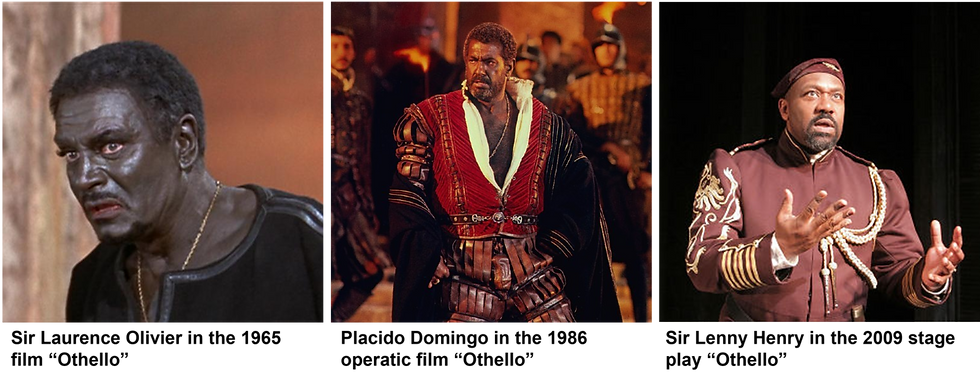
In direct contrast to Olivier and Domingo was the 2009 casting of Sir Lenny Henry in the role of the tragic Moor of Venice (pictured above right). While Sir Lenny was not required to sing as he performed the more traditional stage play, his portrayal of Othello epitomises how it ought to be done. The first two examples are clearly emblematic of whitewashing, while the third is a superb illustration of appropriate and brilliant casting.
Horrible history What follows are some instances of history documentaries, historically themed docudramas and straightforward films or television productions that quite clearly have engaged in forced diversity or identity-conscious casting. Whatever one calls it, the practice is cropping up everywhere. Before proceeding it must be emphasised that the “Horrible History” series always avoids being critical of individuals, especially actors playing a role. Rather, the chosen case studies are intended to highlight historical inaccuracies and then present a more accurate version of history. Wherever possible it is hoped we can learn something more from critiquing each example.
Ann Boleyn (2021)

While some aspects left critics unimpressed, Channel 5's three-part drama about Anne Boleyn was praised for casting black actress Jodie Turner-Smith in the title role. The series was described as a “re-imagining” of Anne Boleyn's life, “re-examining her final five months and her legacy through a feminist lens”. Any intellectually honest historian ought to be troubled by those statements for at least three reasons. The first relates directly to the subject at hand. According to the Radio Times, the producers actively used “identity-conscious casting” for the series in a similar way to how theatre productions have long approached casting historical plays. According to Channel 5, identity-conscious casting “makes space for and embraces how actors and artists can bring their whole identities or even parts of their identities to a character. Actors from minority backgrounds that are not often represented on screen can therefore claim parts that correspond to their personal identities, without being limited by them.” Not bound by the “casting constraints historically adopted within period dramas”, this approach gave the series producers the freedom to tell Anne Boleyn’s story in a way that will “resonate broadly with a contemporary audience.” Tellingly the Radio Times quoted actor Mark Stanley, who plays Henry VIII in the Anne Boleyn cast:
“It was all about this being the right person for the job, rather than what we as a society might perceive as the 'right look' for the job”.
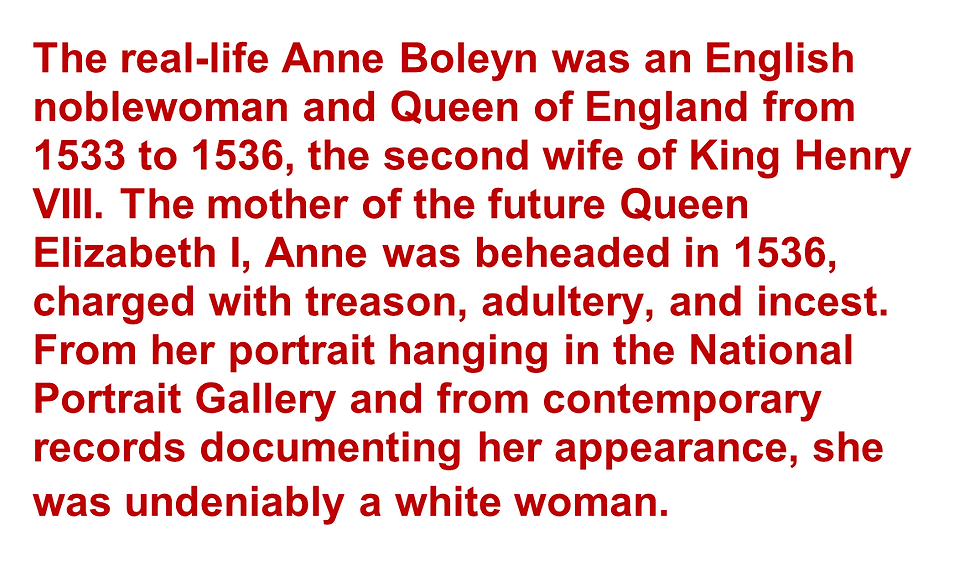
Stanley’s statement is a clear indication that the production traded historicity to appease their perception of “a contemporary audience” and favoured forced diversity. As already stated, that is all well and good in a fictional setting but not if portraying known historical figures. So, while Jodie Turner-Smith’s powerful performance was widely praised, criticism of the race swapping of historical characters and accusations of blackwashing soon followed the series’ airing in June 2021. There is no doubt that Turner-Smith is a fine actress and a superb role model for aspiring black actors but casting her as the very obviously “white” English queen was disingenuous at best. For a viewer new to Ann Boleyn’s story or someone keen to learn more about her, then what they are exposed to is a false representation of Henry VIII’s ultimately doomed second wife. In essence, a lie.
The second concern centres on the self-styled “feminist lens” the writer and producers used to examine Ann Boleyn’s tragic fall from grace. Regrettably, such “-isms” introduce subjectivity to the study of history. In more recent times some individuals or groups, who perhaps rightly or wrongly consider themselves marginalised, have been weaponizing history for their own interests or political aims. The only “lens” required to study the past is objectivity. Not always an easy prospect, but history should not be viewed through 21st-century eyes. To do so risks applying modern notions of morality on people for whom such concepts had yet to be conceived, were irrelevant or did not chime with their lived experience.
To give feminism appropriate and due consideration is a massive topic that deserves the more in depth treatment found elsewhere. For the present purpose, in the classical world and that of Mediæval and Tudor England, our modern notions of feminism were alien and unremarked so for the programme makers to apply current feminist values is to misrepresent the past. In the Classical world we have only one isolated instance of actions that might today be labelled feminist. During the 3rd-century BC a group of women barricaded ancient Rome’s Forum in an attempt to force the highly conservative Republican consul Marcus Porcius Cato to repeal laws limiting women’s use of expensive goods. The highly unusual nature of this incident is probably why it was recorded but is indicative of the relationship between men and women in the Roman world. Over a thousand years later, in the late 14th- and early 15th-centuries, the first notable feminist thinker appears in the historical record. French philosopher Christine de Pisan codified typically feminine behaviour in her treatises on moral instruction, and was credited with agitating for female education, a radical stance at the time. Although clearly active just before the Tudor period, there is no indication that her views had gained any ground with men or women in England.
The third concern is the “re-imaging” of the historical figure or story in question. That effectively means “making it up”, creating a fictionalised version of history. Again, there is the danger of twisting the known or demonstrable facts to satisfy an agenda. Adding or removing elements from the narrative to suit a particular viewpoint is not what reputable historians strive for. Yet to study history is to interpret the past. We cannot for example “know” with any certainty what a historical figure was thinking in any given circumstance unless they documented their thoughts, and then that record survives the centuries for us to discover. The evidence may no longer exist, or what does might be patchy and incomplete. All too often, especially in the age of social media, it is into these knowledge gaps that rumours, falsehoods, conspiracy theories and re-imagined “bad history” is woven. So, studying history is an art that demands we continually ask the six key questions necessary for critical thinking. By thinking critically and questioning the “facts” presented we can counter the bad actors intent on manipulating the past perhaps for nefarious motives.
Wolf Hall (2015 and 2024)

Our second example is “Wolf Hall”, a British television series adaptation of Hilary Mantel's trilogy of novels, a fictionalised biography documenting the life of Thomas Cromwell. The six-part first series, based on the novels “Wolf Hall” and “Bring Up the Bodies”, was initially broadcast on BBC Two in January 2015. It documented the rapid rise to power of Thomas Cromwell in the court of Henry VIII, through the death of Sir Thomas More, to Cromwell's success in freeing the king of his marriage to Anne Boleyn. The first series was a critical success and received eight nominations at the 67th Primetime Emmy Awards and three nominations at the 73rd Golden Globe Awards, winning for Best Miniseries or Television Film. A second series, adapted from “The Mirror & the Light”, the final novel in the trilogy, featured the return of Mark Rylance playing Thomas Cromwell, as well as director Peter Kosminsky and writer Peter Straughan. Filmed between November 2023 and April 2024, the series was first broadcast on 10 November 2024.
Both series of Wolf Hall are without doubt lavish and entertaining. Viewers are offered a fascinating glimpse into an important period of British history, but the production raises the perennial question of how historically accurate is this period drama? Answering that question, Kazim Ladimeji was keen to point out: “It is important to remember that Wolf Hall is a fictionalised historical drama, not a strict documentary reconstruction. Small inaccuracies, especially in props or dialogue, are sometimes inevitable in this genre.”
Hilary Mantel, the author of the original trilogy, was obsessive about ensuring her novels were as historically accurate as possible. She refused to add modern twists or fantastical elements to her historic fiction yet, as Mantel herself maintained, her works were fiction. As a novelist, she claimed she could take her story where “the historian and biographer can’t go”, adding: “However much you learn, factually, there is plenty of scope for imagination.” This blurring of the lines between history and fiction, especially on screen, is problematic. Viewers with little knowledge of the Tudor period accept the lavish sets, superb costuming, and the characterisations as a true representation. But as John Guy, a Tudor historian, noted in 2017 it was “troubling that many students had begun to assume the first Wolf Hall series was 100% accurate.”

So, who is this gentleman (pictured) at Court? By his appearance he is purportedly wealthy and in fact, this actor can be spotted in scenes depicting the Privy Council, the body of advisors to the king who were drawn from the highest echelons of the nobility, senior church leaders and notable legal counsellors. As far as Tastes Of History can discern, the actor is uncredited so we cannot be certain which of the Privy Councillors he is supposedly portraying. For present purposes, however, identifying him is irrelevant because historically he could not have been a member of the Privy Council. The nineteen men upon who’s advice the king relied were all rich, privileged and, most significantly, white. Interested readers might wish to follow the link to a separate post listing Henry VIII’s Privy Councillors in 1540.

But wait one moment. We have stated that Wolf Hall is a fictionalised account of the Tudor court and its intrigues. Moreover, we have also argued that in a modern-day story or one set in a fictional past or an imagined future whether a character, or the actor playing, them is black or Asian is irrelevant. So, is it a problem? In this instance, no, not really. Nor is the presence of an actress portraying one of Queen Jane Seymour’s (Kate Phillips) ladies in waiting in the screenshot. It is on record that director Peter Kosminsky made some changes to the second series including the decision to implement “colour-blind casting” (an alternative term for identity-conscious casting). Unfortunately, viewers of African, Asian or mixed ethnicity might be persuaded that the Tudor court was replete with men and women sharing their same heritage which is simply not true. Bearing in mind John Guy’s earlier comment, colour-blind or identity-conscious casting is inaccurate, misleading and disingenuous to viewers.

Black Tudors In keeping with the “Horrible history” theme, even though Wolf Hall series two overplays the diversity card, it does highlight that people of African origin were living in Tudor England. Indeed, it has been suggested that there were over 200 according to evidence presented by historians such as Imtiaz Habeeb, Onyeka Nubia and Miranda Kaufmann. Perhaps further examples will be discovered but in comparison to the population of England at the time - roughly three million people - 200 Africans represents an insignificant 0.0067% of the populace. Even so, information about these people and their lives has been discovered in letters, legal records and church records of births and deaths. Some came directly from the continent of Africa as traders or as ambassadors. Abd el-Ouahed ben Messaoud came from Morocco to have treaty talks with Elizabeth I, for example. More importantly, there is evidence that people of African origin served in the royal courts of Henry VII, Henry VIII and Elizabeth I. Some also lived in the homes of the nobility as servants of Elizabeth I’s favourite courtiers, Robert Dudley, Sir Walter Raleigh, Sir Francis Drake, Sir William Cecil and Sir Robert Cecil.

Most people of African heritage in Britain were servants, yet this also reflects that many commonfolk in the Tudor period were servants, and of varying status. Some of African heritage, however, worked for themselves as skilled craftspeople. Notable among them was Reasonable Blackman who made an independent living as a silk weaver and lived, with his family, in Southwark, London c. 1579-1592. This was at a time when the silk industry was new to England, but its products were the height of fashion. Blackman probably arrived in London from the Netherlands, which had both a sizeable African population and was a known centre for cloth manufacture. We also know he had a family of at least three children, but sadly lost a daughter, Jane, and a son, Edmund, to the plague that struck London in 1592.
John Blanke As far as the Court of Henry VIII is concerned, the only person of black origin documented is the trumpeter, John Blanke. The two images of Blanke in the Westminster Tournament Roll of 1511 comprise the only known portrait of a Black Tudor. It is believed that he may have come to England in 1501 as part of Catherine of Aragon’s household staff. Records tell us that John was present at the court of Henry VII from at least 1507. He was employed by both Henry VII and Henry VIII, and there is evidence to show that in 1509 he performed at both Henry VII’s funeral and Henry VIII’s coronation.

The Westminster Tournament Roll depicts John as a Royal trumpeter in 1511 at the joust held to celebrate the birth of Henry VIII and Catherine’s son, also named Henry, who died shortly afterwards. John was one of a large group of trumpeters who announced the entrance of the King at the beginning and end of the joust. In Tudor society, trumpeters were valued musicians being employed for court occasions, on the battlefield and to announce the arrival of important royals.
John received eight old pence a day in the reign of Henry VII. This was double the wage of an ordinary farm labourer and three times that of a servant. In fact, John may have been so valued that he was successfully awarded a pay rise from Henry VIII. In 1512, he received a gift of new clothing from the King when he got married. John disappears from the historical record after this gift. We can infer from this that he may have left royal service at this point, but without written evidence, we cannot know for certain.
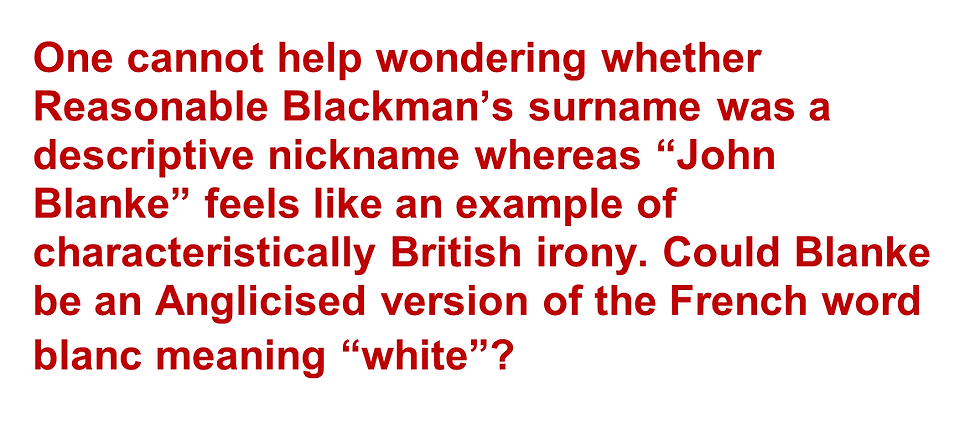
Jacques Francis An expert swimmer and free diver, both skills common to his native coast of West Africa, but extremely rare in Tudor England. His ability to hold his breath for a long time and dive down to the seabed secured Francis a role in the team hired to salvage guns from the wreck of the Mary Rose in 1546. Henry VIII’s flagship had sunk in 1545 along with most of its crew during a battle with the French off the coast of Portsmouth. Francis’ job was to dive to the ocean bed and tie ropes around objects that would then be pulled up; a dangerous job needing years of practice.
Jacques Francis and his coveted diving skills are known to us today because he was a witness in a court case in February 1548. Francis gave evidence when his employer was accused of stealing tin and other materials from the wrecks of two Italian merchant ships, the Sancta Maria and the Sanctus Edmundus. As not every member of Tudor society was allowed to give evidence in court, this may be an indicator that Jacques Francis was well respected.
Gunpowder Siege (2024)

Our third and final example centres on the events remembered by Britons each year on the 5th of November. It is a time of fireworks displays, chilly outdoor night-time parties, and bonfires. Sadly, increasingly few know what really happened when the infamous Guy Fawkes tried (but failed) to blow up the English parliament in 1605. The plot was part of a much bigger plan, as Fawkes and his associates fought to stop Catholic oppression under King James I. Sky History’s Gunpowder Siege (2024) “dramatically re-imagines [there’s that phrase again] the most infamous rebellion plot in British history, shattering the myths to reveal the largely forgotten, gripping truth behind the Gunpowder Plot.” The three-part series focuses on the aftermath of the Plot, spotlighting its three leaders - Robert Catesby, his cunning cousin Thomas Wintour, and their fellow Catholic, and ruthless enforcer, Thomas Percy. It is dramatic, compelling and well-acted.

It was Catesby (c. 1572 – 8 November 1605) who inspired and led the unsuccessful attempt to kill King James I (and VI) in November 1605. He was the third and only surviving son and heir of Sir William Catesby of Lapworth in Warwickshire, by his wife Anne Throckmorton, a daughter of Sir Robert Throckmorton (c.1513–1581), Knight of the Garter, of Coughton Court also in Warwickshire. So, Catesby was a Warwickshire lad through and through. Why then was the character of Robert Catesby played by British actor Chukwuma (Chuku) Modu? He was born on 19 June 1990 to a mixed-race Nigerian-German father and an Anglo-Irish mother in Chiswick, West London. Mr Modu is another talented actor, so this is not a criticism of his performance but, ignoring the historical accuracy, his casting feels like tokenism. Robert Catesby was, by all accounts, not a tall, handsome heartthrob and certainly not of mixed ethnicity.

Onion bottles In one scene the conspirators are sat at a table where an onion bottle was prominently featured. In the screenshot pictured, the bottle can just be made out to the left side of the image in front of Catesby (played by Choku Modu). Before explaining why this is an anachronism, high praise is due for the interior lighting effects which perfectly capture the ambience of the period. Note that only two modest candles are burning rather than the room being flooded with candlelight. The latter is usually what is depicted in films but is historically inaccurate unless the characters are enormously wealthy. Oil for lamps, candles or rushlights were expensive to burn and would not be wasted frivolously.
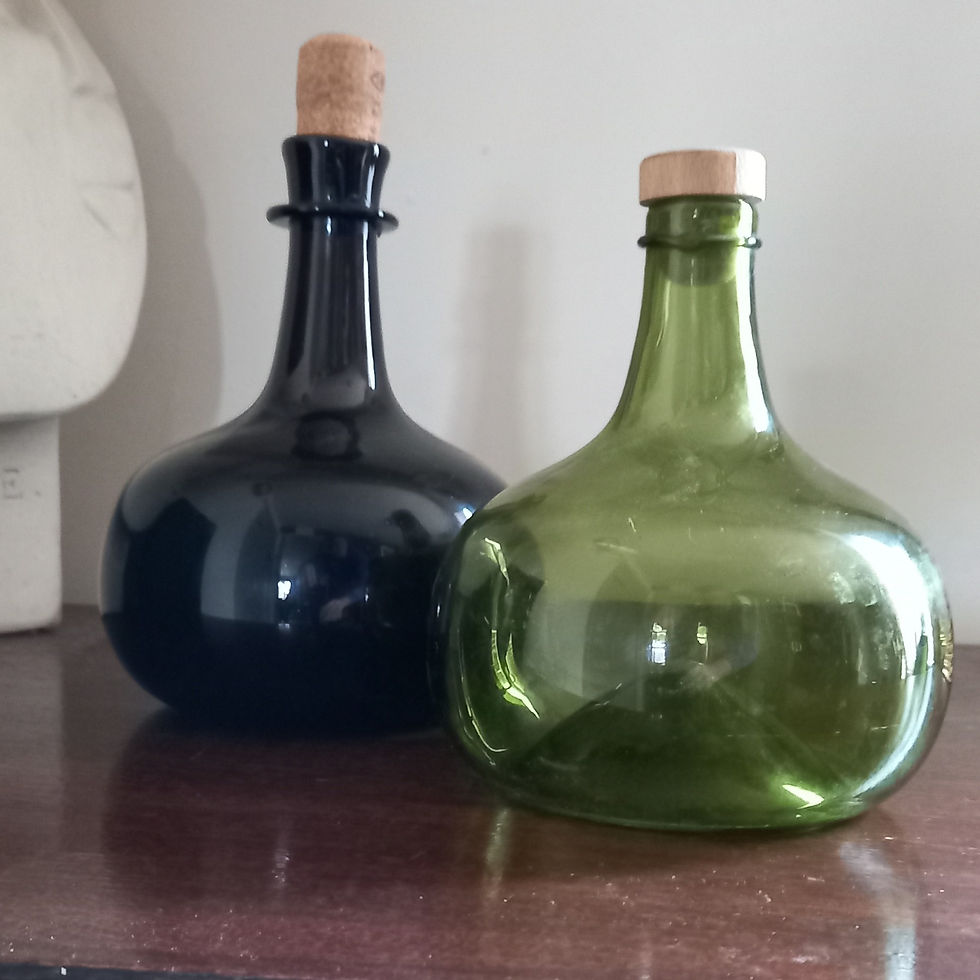
Returning to the subject of “onion” or “glass onions”, these were indeed a bottle shape developed and used during the 17th- and 18th-centuries. Unfortunately, the design was not developed until nearly a quarter of a century after Catesby et al. were all dead. Nevertheless, it is true that new techniques of glassmaking at the beginning of the 17th-century were producing glass bottles to replace the pottery vessels that traditionally held wine and spirits. These wine bottles, however, were small and thin walled making them difficult to store and ship. During the 1630s privateer turned inventor Kenelm Digby, who conveniently owned a glass works, teamed up with James Howell to create a method using hotter furnaces to make stronger glass. Digby's technique produced wine bottles that were stronger and more stable than contemporary types and protected the contents from light due to their green or brown translucent, rather than clear transparent, colour. These early bottles, usually referred to as “shaft and globe” bottles, evolved into the onion bottle shape by the 1670s. By the end of the 17th-century, the design was gradually developed to be stouter with a broad base and short neck. It then became elongated during the onset of the 18th-century to a style familiar today. So, while the onion bottle sitting on the table looks “Olde Worlde” it is in fact an anachronism. That the set-dressers clearly did not realise speaks volumes about how media productions are content to do just enough to make a scene “look right”. Although to be fair most audiences will not have spotted such a minor mistake.

Flintlock muskets The final episode of the three, “The Last Stand”, focuses on the aftermath of the failed Plot. Instantly branded as the most wanted men in England, the conspirators race from London to the Midlands, desperately seeking to ignite a Catholic rebellion. When that also fails, viewers see the fugitives barricading themselves in Holbeche House where Catesby and the others reflect on the years of persecution that led to that moment. It is during the portrayal of the siege with the King's men that the conspirators are shown well-equipped with several flintlock muskets.

Flintlock is a general term for any firearm that uses a flint-striking ignition mechanism. The first such weapons appeared in Western Europe in the early 16th-century. The snaplock, for example, was probably invented shortly before 1517 and was undisputedly in use by 1547. Their cost and the lock’s fragility limited their use, however. Around 1662, for example, only one in six firearms used by the British royal army was a snaphaunce, the rest being matchlocks. The development of firearm lock mechanisms had proceeded from the matchlock to wheellock to the earlier flintlocks (snaplock, snaphaunce, miquelet, and doglock) in the previous two centuries, and each type had been an improvement, contributing design features to later firearms which were useful. As an example, shortly after King Louis XIII accession to the throne in 1610, French court gunsmith Marin le Bourgeoys incorporated various features to create what became known as the flintlock or true flintlock. The new mechanism gradually replaced earlier firearm-ignition technologies, such as the matchlock, the wheellock, and earlier flintlock mechanisms such as snaplock and snaphaunce. By the late 17th-century, the flintlock had proven easier to manufacture, relatively inexpensive, reasonably weatherproof and, most importantly, provided an instant and reliable way of igniting gunpowder in a gun’s chamber. So successful were these firearms that the British Army's muzzle-loading smoothbore flintlock, officially titled the Land Pattern Musket, remained in use for over a hundred years. Nicknamed “Brown Bess”, this musket and its derivatives, all with a calibre of 0.75 inches, were the standard long guns of the British Empire's land forces from 1722 until 1838, when they were finally superseded by a percussion cap smoothbore musket.

So, while flintlocks had been around for the best part of a century, in the England of 1605 they would have been far too costly and thus not so prevalent as implied in the episode. Moreover, the flintlocks shown on screen appear to be of a much later period, and it is just possible that they are in fact the aforementioned Brown Bess muskets. A more accurate portrayal should have used matchlock muskets similar to the one pictured above which were the common firearm during the later English Civil Wars from 1642 to 1653. It is suspected that the armourer supplying the production may have found flintlocks easier to obtain. That said, the number of replica, firing matchlock weapons in the possession of musketeers with the English Civil War Society (ECWS) or The Sealed Knot is significantly large and should have been easy to hire. That said, it is a little easier for the actors to learn to confidently handle and shoot a flintlock than setting a match which takes a little more training. As an example, take a look at the complex and lengthy matchlock musket drills (right) written for musketeer re-enactors by Al Slater, a member of “Colonel Edward Montague's Regiment of Foot” in the ECWS. By comparison, it should be evident that the loading drills for an 18th-century musket, as typified by the Brown Bess, are far simpler, and far safer. It therefore makes perfect sense that the firearms experts and armourers for Gunpowder Siege chose to use flintlocks even if ever so slightly anachronistic.
Conclusion It must be emphasised that we are all for diversity and inclusion, but can we agree that arbitrary quotas are kept out of historical documentaries? It seems perfectly acceptable in a production like Bridgerton where the primary purpose is purely entertainment. But a history documentary's objective is surely to accurately inform the audience. In almost any other context, inclusive casting is essential to ensure as many people as possible are involved in all kinds of projects. But when it comes to historical documentaries, we are not alone or in favour of the media’s virtue signalling choices. If a documentary's goal is to educate the audience, why mislead them with identity-conscious casting that effectively removes the viewer from the historical world it is trying to recreate? Artistically, it does not necessarily benefit the actors, and from an informational standpoint, it does not serve the audience either. And yes, we know Wolf Hall is an outlier by dint of it being a fictionalised account of Tudor period intrigue. Yet the popularity and impact of the two series warrants its inclusion in light of John Guy’s observation “that many students had begun to assume the first Wolf Hall series was 100% accurate.” Television, movies, video games and social media platforms can have a far reaching influence which can be entertaining and as historically accurate as possible. Bon appétit!
References:
BBC Bitesize, “Africans and their lives in Tudor England”, available online (accessed 18 March 2025).
Black History Month 2025, “BLACK TUDORS…A peek into the lives of ten people of the African Diaspora who lived in Tudor Britain”, available online (accessed 18 March 2025).
Carr, F. (2021), “Why Channel 5's Anne Boleyn is a Black woman - a look at the real Anne”, RadioTimes.com, available online (accessed 9 January 2025).
Ladimeji, K. (2024), “How Historically Accurate Is Wolf Hall?”, Oxford Open Learning, available online (accessed 17 March 2025).
O'Hehir, A. (2001), “The book of the century”, Salon, available online (accessed 16 January 2025).
Quiroga, S.A. (2022), “Forced Diversity’ In Movies Is Not a Thing – But Here’s Why Some People Are So Scared of It”, De Gruter Conversations, available online (accessed 16 December 2024).
Slater, A. (1998), “Musket Drill”, English Civil War Times, available online (accessed 18 March 2025).
Endnotes:
1. Jenkins, S. (2024), “Should period dramas reflect modern sensibilities”, in “The Conversation”, BBC History Magazine (July edition), p. 12. ▲
2. A “straw man fallacy” is the informal fallacy of refuting an argument different from the one actually under discussion, while not recognizing or acknowledging the distinction. ▲
3. Writing in Salon, Andrew O'Hehir suggests the novel is Tolkien's lament over the impact of the Industrial Revolution and the environmental degradation of England's formerly “green and pleasant land”. ▲

Academic writing assignment help.
Websites to buy essays online.
Best websites for programming assignment help.
Nursing assignment help.
Best research paper.